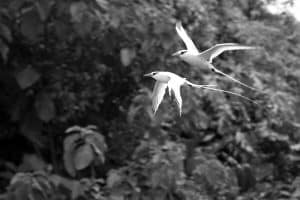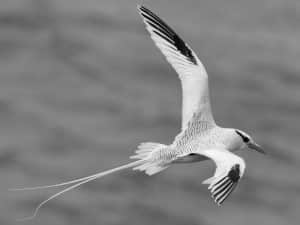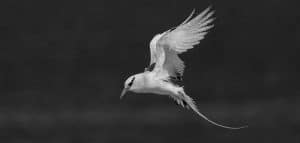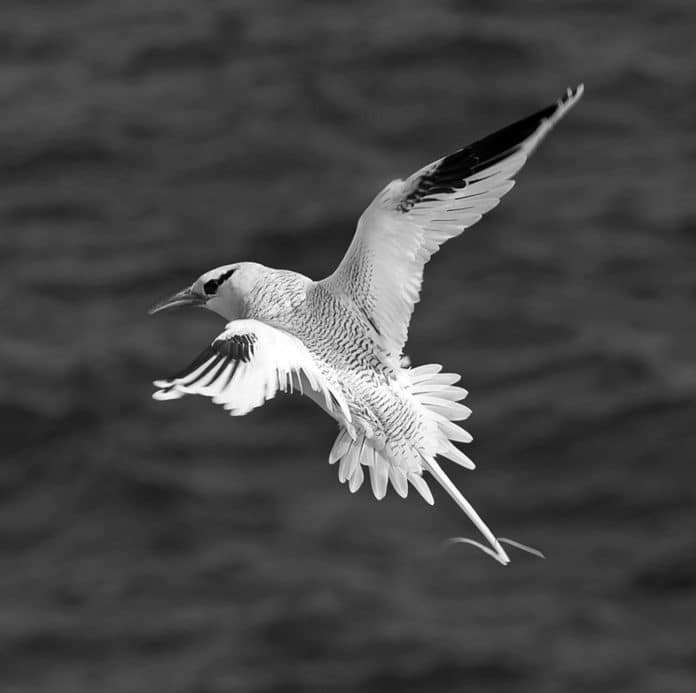Introduction to the Red-Billed Tropicbird
The Red-Billed Tropicbird is a stunning bird species that graces the Tanzanian waters with its elegant presence. With its vibrant red bill and long, white tail feathers, this aerial marvel is truly a sight to behold. Found along the coastal areas of Tanzania, these birds are known for their graceful flight and unique breeding behaviors. In this article, we will explore the habitat, physical characteristics, breeding behavior, feeding habits, and conservation efforts related to the Red-Billed Tropicbird in Tanzania.
Habitat and Distribution of the Red-Billed Tropicbird in Tanzania

The Red-Billed Tropicbird is primarily found in the coastal regions of Tanzania, where it inhabits islands and rocky cliffs. These birds prefer nesting on inaccessible ledges and crevices, providing them with protection from predators. The warm waters of the Indian Ocean surrounding Tanzania offer an abundance of food for these birds, making it an ideal habitat for their survival. While they are most commonly seen in the Zanzibar Archipelago and Mafia Island, Red-Billed Tropicbirds can also be spotted along the mainland coast.
Physical Characteristics of the Red-Billed Tropicbird
The Red-Billed Tropicbird is a medium-sized seabird with a wingspan of approximately 1 meter. Its most distinctive feature is its long, white tail feathers, which can be as long as the bird’s body. The bird’s plumage is predominantly white, with black markings on its wings and back. Its bill is a vibrant red color, contrasting beautifully against its white feathers. The Red-Billed Tropicbird has webbed feet, which are used for swimming and diving in search of food.
Breeding Behavior and Lifecycle of the Red-Billed Tropicbird
Red-Billed Tropicbirds are monogamous birds that form long-term pair bonds. During the breeding season, which typically occurs between November and April, the birds engage in elaborate courtship displays. The male performs aerial acrobatics, soaring high in the sky and diving towards the female, while vocalizing to attract her attention. Once a pair is formed, they build a nest together on a rocky ledge or in a crevice. The female lays a single egg, which both parents take turns incubating. After approximately 6 weeks, the egg hatches, and the chick is cared for by both parents until it is ready to fledge.
Feeding Habits and Diet of the Red-Billed Tropicbird

The Red-Billed Tropicbird is a carnivorous bird that primarily feeds on fish and squid. With its keen eyesight, it scans the ocean surface from high above and dives into the water to catch its prey. Using its sharp, pointed bill, it snatches fish from the water or plucks them from the surface. The bird’s streamlined body and long tail feathers aid in its agile movements, allowing it to maneuver swiftly through the air and water. Red-Billed Tropicbirds are highly skilled hunters and can catch their prey with great precision.
Threats and Conservation Efforts for the Red-Billed Tropicbird in Tanzania
While the Red-Billed Tropicbird population in Tanzania is relatively stable, there are still several threats that pose a risk to their survival. One of the main threats is habitat destruction caused by coastal development and tourism activities. The disturbance of nesting sites can disrupt breeding patterns and lead to a decline in population. Additionally, pollution and overfishing in the waters surrounding Tanzania can impact the availability of food for these birds. To mitigate these threats, conservation efforts are being implemented, including the establishment of protected areas and raising awareness about the importance of preserving the Red-Billed Tropicbird’s habitat.
Best Locations for Birdwatching the Red-Billed Tropicbird in Tanzania
If you are a birdwatching enthusiast, there are several prime locations in Tanzania where you can observe the Red-Billed Tropicbird in its natural habitat. The Zanzibar Archipelago, including Unguja and Pemba Islands, is a hotspot for these birds. The rocky cliffs and pristine beaches offer ideal nesting sites, providing ample opportunities for sightings. Mafia Island, known for its marine biodiversity, is another great location to spot these birds. The island’s untouched beauty and crystal-clear waters make it a paradise for birdwatchers.
Tips for Observing and Photographing the Red-Billed Tropicbird

To make the most of your birdwatching experience and capture stunning photographs of the Red-Billed Tropicbird, here are a few tips to keep in mind. Firstly, bring a good pair of binoculars or a spotting scope to get a closer look at the birds in their natural habitat. Secondly, be patient and observant, as these birds can be elusive and may require some waiting to catch a glimpse of them. Finally, respect their space and avoid causing any disturbance that could disrupt their breeding or feeding behaviors. By following these tips, you can have a memorable and responsible birdwatching experience.
Interesting Facts about the Red-Billed Tropicbird
- The Red-Billed Tropicbird is also known as “boatswain bird” or “bosun bird” due to its distinctive call, which resembles a naval whistle.
- These birds are expert fliers and can travel long distances without flapping their wings, using thermals and wind currents to glide effortlessly.
- Red-Billed Tropicbirds have a unique way of drinking water. They skim the surface while in flight, dipping their bills into the water to scoop up small amounts.
- The long tail feathers of the Red-Billed Tropicbird are used in courtship displays, where the male performs aerial maneuvers to attract a mate.
- These birds have a lifespan of approximately 20-30 years, with some individuals living even longer in ideal conditions.
Conclusion: Appreciating the Beauty and Importance of the Red-Billed Tropicbird in Tanzania
The Red-Billed Tropicbird is not only a magnificent sight to behold but also an important species in the coastal ecosystems of Tanzania. Its presence serves as an indicator of the health of the marine environment and the conservation efforts being made to protect it. By understanding the habitat, physical characteristics, breeding behavior, feeding habits, and conservation needs of the Red-Billed Tropicbird, we can appreciate the beauty of these aerial marvels and work towards ensuring their survival for future generations. So, the next time you find yourself in the Tanzanian coastal areas, keep an eye out for the majestic Red-Billed Tropicbird and marvel at its grace and elegance.

































